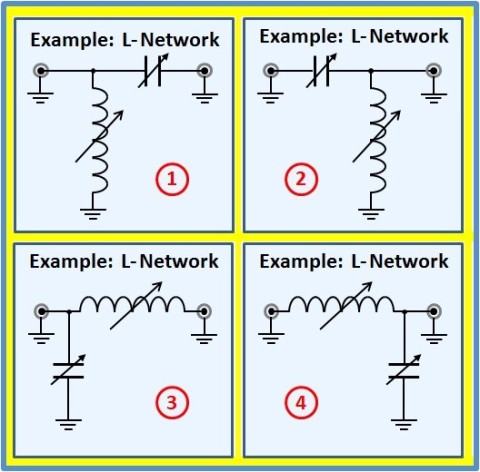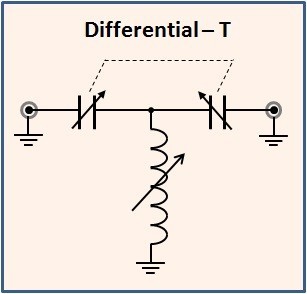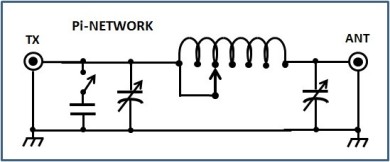Antenna Tuners
ASYMETRICAL MATCHBOXES
(also called "Unbalanced Matchbox")
WHAT IS IT?
An "Assymetrical" or "Unbalanced" Matchbox is a matchbox that was designed to be used primarily with unbalanced (asymmetrical) antennas. These are typically coax-fed antennas but may also be other types.
Examples of Asymmetrical Antennas:
- Long Wire
- Ground Plane
- Windom (OCF)
- Mobile Whip
A SIMPLE DIPOLE may sometimes require a matchbox under certain conditions:
- Low band antennas for 160 & 80m (including dipoles) typically do not have a broad enough bandwidth to provide a good SWR across the entire band. An Asymmetrical (Unbalanced) Matchbox is
very useful here.
- A dipole on most bands, 40m and above, is capable of presenting a good enough match (low SWR) to the transmitter across the entire band, so a matchbox is normally not required. (Exception: high end of 10m).
- Sometimes people want to us a coax-fed dipole on another band for which it was not intended. They use a matchbox to match the antenna to their transmitter, obtain a 1:1 match and assume
thay have a good antenna for that band. NOT!
- I'm not going to say you should never do this. Sometimes it's a good crutch to help in emergencies, but it is a VERY POOR excuse for an antenna when used like that. Normally you should never use the antenna like that.
- There is one exception: a 40m dipole is actually a pretty good antenna on 15m, especially with the help of a matchbox it can be very effective.
TYPES OF ASYMMETRICAL MATCHBOXES:
1. LINK-COUPLED MATCHBOX
2. L-NETWORK MATCHBOX
3. T-NETWORK MATCHBOX
3a. DIFFERENTIAL-T MATCHBOX
4. Pi-NETWORK MATCHBOX
Although we could use a Pi-Network or Link-Coupled matchbox, with just one exception, you don't find these offered commercially anymore. The simple reason: "cost". The other solutions use components which are not as costly as these two.
THEREFORE WE WILL LOOK AT THE T-NETWORK AND L-NETWORK IN MUCH
MORE DETAIL THAN THE LINK-COUPLED OR PI-NETWORK MATCHBOXES.
- Commercial only the "T" and "L" are offered.
- "T" is by far more popular than "L".
- But is it better than "L"? Worse?
THE SHORT ANSWER IS: EACH HAS ADVANTAGES AND DISADVANTAGES.
WHICH ONE YOU SHOULD YOU USE DEPENDS ON MANY THINGS (described below).
1. LINK-COUPLED-MATCHBOXES:
Link-Coupling is one of the oldest technologies used for matching an antenna to the transmitter. There are many different configurations of link-coupling, from very simple, like the one shown on the right, to very elaborate circuits using differential capacitors.
The efficiency is very good but covering multiple bands can be a challange, especially for the bandswitch.
This is probably the main reason that Link-Coupling is not found commercially available.
Although the Link-Coupled matchbox was also use in asymmetrical applications long ago, in the past 50 years it has mostly been used in symmetrical applications. In the meantime there are no more commercial Link-Coupled matchboxes available (that I know of) on the market.
I will cover Link-Coupled matchboxes in more detail under Symmetrical Matchboxes.
The "T-Network" and "L-Network"
[The 2 most popular circuit designs for asymmetrical matchboxes.]
.
At first glance, the T and L circuits are very similar, with the T having just one more component than the L. There are advantages and disadvantages of both technologies.
T or L ?
Most matchboxes today are T-Network. These matchboxes share common routes back to the original "Ultimate Transmatch", described by Lew McCoy, W1ICP (SK) in QST in 1970 (possibly earlier). Their advantage is that they use common components and don't require a lot of fancy switching.
The L-Network appears even simpler, but in practice it is not. It requires more switching and some pretty hefty component values in order to be able to match as broad of a range of impedance as the average T-Network matchbox. Hower when matched, it is always matched at the point of maximum efficiency and generally more effecient (less internal loss) than the T-Network.
For more details, see below..
2. L-NETWORK MATCHBOXES:
In theory, the L-Network is all you need to match any impedance. As I said, "in theory."
In practice, in order to match a broad impedance range, you need some very large, and very small values of components. In addition, a large variable capacitor capable of matching on 160m is very expensive and would have too much minimum capacitance for use on 10m. As a result, a much smaller variable capacitor is used together with several fixed-value capacitors, switched in when required.
The problem does not stop there. All of the capacitors must be connected to one side of the coil for matching low impedances and connected to the other side of the coil for matching high impedances. As a result, some tricky switching is required if you want to match everything.
There are a handful of L-Network matchboxes on the market but most do not incorporate the complex switching circuit to enable it to match from 10 Ohms to 3000 Ohms. To my knowledge, currently the only L-Network on the market that can do this is the TEN-TEC Model 238, and its successors, the Model 238-A, the Model 238-B, which are only available used. The current Model 238-C is still available new, but it is not cheap.
L-NETWORK CONFIGURATIONS:
Shown above are the 4 "possible" configurations of an L-Network.
Versions 1 and 4 are high-pass matching networks.
Versions 2 and 3 are low-pass matching networks.
In practice, usually only versions 3 and 4 are used for Antenna Matchboxes.
- VERSION 3 is used whenever the antenna has LOW impedance (less than 50 Ohms)
- VERSION 4 is used whenever the antenna has HIGH impedance (greater than 50 Ohms)
Advantages of L-Network:
- Easy to tune to the optimum setting
- Only one setting (per antenna, per band) will yield the optimum SWR
- When set for minimum SWR, it always corresponds to maximum efficiency
- Fewer components than with a T-Filter (less knobs to tune)
- LESS LOSS THAN WITH T-FILTER !!! (BIGGEST ADVANTAGE)
Disadvantages of L-Network:
- To cover the same impedance matching range as the T-Filter, it requires some pretty extreme component values, AND. . .
- It also requires re-configuration of the inductor and capacitor to all 4 circuits shown above.
- In practical applications, achieving the extreme component values needed requires switching the capacitor back and forth between the input and output side of the network, switching multiple capacitors in parallel with the main tuning capacitor, and swapping the positions of the inductor and capacitor.
- Without all of the above, its impedance matching range is limited, and not as broad as that of the T-Filter matchbox.
- There are very few commercial (manual) L-Network tuners on the market and all of them are relatively expensive. Here are a couple:
- TEN-TEC Model 238/238A/238B/238C ("C" is the current model)
- Viking Nye Matchbox (only available on the used market)
COMMENTS:
The L-Network is a very efficient, low loss matchbox. Unfortunately it is difficult to design enough hardware into one single matchbox which is capable of matching both low impedances and high impedance across all HF bands.
As a result all L-Network matchboxes are expensive and many have a somwhat limited matching range.
If you are looking for a good matchbox for a specific impedance range, and highest efficiency is your main criteria, the L-Network is the way to go. If you want one that does everything, be prepared to spend a lot of money.
PERSONAL COMMENT: I own a TEN-TEC "Model 238-B" L-Network Matchbox, and it falls into the category, "til death do us part".
3. T-NETWORK MATCHBOXES:
See circuit diagram at the top of the page.
In the past 30 years, the T-Network has established itself as the most popular matchbox design found in most ham shacks. It is a simple design that easily covers multiple bands, and it can be built using common, inexpensive components.
The T-Network can easily match a broad range of impedances, making it the ideal matchbox for matching "whatever comes your way". Unfortunately it is not always the most effecient matchbox.
The BIGGEST PROBLEM with the T-Network is its internal loss - power lost inside the matchbox. Through improper tuning by the operator, the losses can be even higher - sometimes 50% or more. This is mainly due to improper tuning by the user, not the design of the tuner.
Advantages of T-Network Matchboxes:
- Simple circuit covers a broad frequency range
- Able to easily match a very broad impedance range
- Component values and physical sizes are practical
- Component costs are reasonable
Disadvantage of T-Network Matchboxes:
- Difficult to tune / difficult to find the best setting
- Multiple settings "appear" to be optimum (show low SWR), but . . .
- . . . when tuned to these wrong settings, these matchboxes heat up, have unnecessary loss, and can even burn up.
- VERY OFTEN USED AT LESS THAN OPTIMUM EFFICIENCY SETTING !!!
- The operator needs to engage his brain when tuning!
COMMENTS:
This is probably the best matchbox technology for most hams who are just beginning and do not know yet what they will ultimately need. Selecting this matchbox technology is a low-risk choice, BUT IF YOU DON'T TUNE IT RIGHT, YOU MAY LOSE UP TO 50% OF YOU POWER INSIDE THE MATCHBOX. It is possible to get better solutions for some antenna applications, but at least this matchbox should always find a good match to the antenna. GOOD STARTER MATCHBOX!
IF YOU CHOOSE THIS MATCHBOX, YOU MUST LEARN HOW TO TUNE IT PROPERLY!
See: Tuning the T-Network
3a. DIFFERENTIAL-T MATCHBOXES:
The " Differential-T " . . . (a good compromise)
- Theoretically it has the same broad matching impedance range as the normal T-Filter matchbox.
- It only finds one setting of L and C which provide the best SWR. This is also the setting with the highest effeciency. This eliminates the possibility of tuning to the wrong position. (nothing can go wrong)
- In theory, slightly more loss than a properly tuned classical T-Matchbox.
- Although it theoretically has a slightly lower effeciency than the standard T-Matchbox, in practical situations it is better because you can never tune it to the wrong settings, so you always have it tuned to its optimum setting.
- BUT, the physical limits of the size of the enclosure prohibits using variable capacitors with as many pF as the standard T-Filter uses; as a result, the impedance range that you can match with the models that are on the market is not as great as the range of a standard T-Filter matchbox.
DIFFERENTIAL-T CIRCUIT:
At first glance, it looks just like the classical T-Filter matchbox.
A closer look reveals the differences:
- The input and output capacitors are tied together and tuned together.
- The input and output capacitors are 180 degrees out of phase; when the input capacitor is at maximum capacitance, the output capacitor is at minimum, and vice versa.
These simple changes result in the circuitry finding only one single point of best SWR, and this point always coincides with maximum effeciency. This eliminates the main problem with the original T-Filter matchbox: user error.
In the interest of keeping costs low, istead of using two separate capacitors ganged together, typical commercial units use a single "differential capacitor". This capacitor is a lot longer than a normal variable capacitor, and madates using a much deeper cabinet. To fit it all into a managable size, the maximum value of each half of the capacitor is not as high as the value typicall used for each capacitor in the original T-Filter. As a result, the Differential-T matchboxes currently on the market do not cover as broad of an impedance matching range as the original T-Filter matchbox.
ADVANTAGES OF THE DIFFERENTIAL-T MATCHBOX:
- Easier to tune to minimum SWR than the classical T-Matchbox
- At minimum SWR, the Differential-T is always operating at its most efficient tuning position.
DISADVANTAGES OF THE DIFFERENTIAL-T MATCHBOX:
- The impedance matching range of the Differential-T Matchbox is not as broad as that of a classical T-Matchbox.
- Their over-sized (long) differential variable capacitor mandates a very deep enclosure, which is often difficult to place on your desktop.
- There are very few Differential-T matchboxes on the market. As a result, these tuners are usually more expensive than a classical T-Matchbox.
Examples:
- MFJ-986 (rated 1.5 kW)
- Palstar AT-500 (rated 500w)
- Palstar AT2KD (rated 2 kW)
BOTTOM LINE: THE DIFFERENTIAL-T IS A GOOD CHOICE WHEN YOU ARE LOOKING FOR A HIGH POWER MATCHBOX WITH A TUNING RANGE SIMILAR TO THE RANGE OF THE BUILT-IN TUNERS FOUND IN TRANSCEIVERS.
4. Pi-NETWORK MATCHBOXES:
.
The Pi-Network Matchbox, like the Link-Coupled Matchbox, is more of a device from the past, rather than the present. This is in no way due to its performance, but rather to the cost of the components required to implement a Pi-Network Matchbox capable of matching the required impedances on all HF bands.
The circuit on the right shows an extra capacitor on the input side. In reality there would probably be several capacitors, which are switchable on demand, depending on the antenna's impedance. We do this rather than using a larger variable capacitor because a larger variable capacitor would have too high of a minimum capacitance to be used on 10m.
Although you could build this matchbox with a roller inductor, you usually only see it with switched inductance. The only Pi-Network matchbox still on the market today is a Remote Matchbox and uses switched inductance.
The Pi-Network matchbox has very good efficiency and also has the added advantage of surpressing harmonics. Although this is old technology, it is still a great concept. It's only problem is, it is expensive to implement in a way that it has a broad impedance matching range over the entire hf spectrum.
I know of only one company (HamWare) making and selling Pi-Network Matchboxes today. HamWare is located here in Germany and its products are VERY EXPENSIVE - (and also very good).
ADVANTAGES OF THE Pi-NETWORK:
- Able to match a very broad range of impedances
- Able to match the entire hf spectrum (assuming sufficient switchable components)
- Low loss / very efficient (if tuned correctly)
- Has excellent harmonic surpression
DISADVANTAGES OF THE Pi-NETWORK:
- High loss when tuned wrong
- Requires components with very large and very low values
- Components are VERY EXPENSIVE. Much more so than with other matchbox types
- Only one commercial source of Pi-Network Matchboxes (HamWare* in Germany)
- HamWare AT615-U (1.5 kW)
- This is a manual remote matchbox with separate matching unit for outside and control unit for the desktop
- HamWare also make two similar Symmetrical Pi-NETWORK matchboxes. More on this under Symmetrical Matchboxes.
- HamWare AT615-U (1.5 kW)
COMMENTS:
The Pi-Network Matchbox is a great technology, with very low internal loss and it also offers good harmonic surpression. Unfortunately the cost of components today has delegated this technology to the history books.
In the past, companies such as R.L. DRAKE marketed Pi-Network matchboxes. In the meantime these have become collectors' items and are difficult to find.































